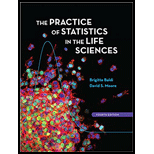
(a)
To define the individuals studied, the type of study and the explanatory and response variables and also find whether the variables are quantitative or categorical.
(a)
Answer to Problem 20.5AYK
The individuals studied are infants with severe respiratory distress, the type of the study is randomized experiment, the explanatory variable is treatment provided to infants and the response variables is the infant survival and also the variables are quantitative.
Explanation of Solution
In the question, it is given that there are safe and effective interventions to treat respiratory failure in new-borns but they are typically costly. Researchers compared the survival of infants with severe respiratory distress who were treated at random either with the new bCPAP machine or nasal oxygen therapy, serving as a control. The published findings report that survival rate for neonates receiving bCPAP was
(b)
To state the corresponding null and alternative hypotheses using mathematical symbols.
(b)
Answer to Problem 20.5AYK
Explanation of Solution
In the question, it is given that there are safe and effective interventions to treat respiratory failure in new-borns but they are typically costly. Researchers compared the survival of infants with severe respiratory distress who were treated at random either with the new bCPAP machine or nasal oxygen therapy, serving as a control. The published findings report that survival rate for neonates receiving bCPAP was
(c)
To check whether the conditions are met.
(c)
Answer to Problem 20.5AYK
Yes, they are met.
Explanation of Solution
In the question, it is given that there are safe and effective interventions to treat respiratory failure in new-borns but they are typically costly. Researchers compared the survival of infants with severe respiratory distress who were treated at random either with the new bCPAP machine or nasal oxygen therapy, serving as a control. The published findings report that survival rate for neonates receiving bCPAP was
Thus, the conditions are met because the data are reasonably random and representative of the corresponding populations. Also, the counts of successes and failures in both the samples are large enough.
(d)
To obtain the test statistics and P-value and then conclude in context.
(d)
Answer to Problem 20.5AYK
So, we have sufficient evidence to conclude that the rate of survival is higher for babies receiving bCPAP than in control group.
Explanation of Solution
In the question, it is given that there are safe and effective interventions to treat respiratory failure in new-borns but they are typically costly. Researchers compared the survival of infants with severe respiratory distress who were treated at random either with the new bCPAP machine or nasal oxygen therapy, serving as a control. The published findings report that survival rate for neonates receiving bCPAP was
Thus, to do the mechanics of a hypothesis test for equality of population proportions we will use the calculator
Thus, by using the calculator
As we know that if the P-value is less than or equal to the significance level then the null hypothesis is rejected, so we have,
Thus, we have sufficient evidence to conclude that the rate of survival is higher for babies receiving bCPAP than in control group.
Want to see more full solutions like this?
Chapter 20 Solutions
Practice of Statistics in the Life Sciences
 MATLAB: An Introduction with ApplicationsStatisticsISBN:9781119256830Author:Amos GilatPublisher:John Wiley & Sons Inc
MATLAB: An Introduction with ApplicationsStatisticsISBN:9781119256830Author:Amos GilatPublisher:John Wiley & Sons Inc Probability and Statistics for Engineering and th...StatisticsISBN:9781305251809Author:Jay L. DevorePublisher:Cengage Learning
Probability and Statistics for Engineering and th...StatisticsISBN:9781305251809Author:Jay L. DevorePublisher:Cengage Learning Statistics for The Behavioral Sciences (MindTap C...StatisticsISBN:9781305504912Author:Frederick J Gravetter, Larry B. WallnauPublisher:Cengage Learning
Statistics for The Behavioral Sciences (MindTap C...StatisticsISBN:9781305504912Author:Frederick J Gravetter, Larry B. WallnauPublisher:Cengage Learning Elementary Statistics: Picturing the World (7th E...StatisticsISBN:9780134683416Author:Ron Larson, Betsy FarberPublisher:PEARSON
Elementary Statistics: Picturing the World (7th E...StatisticsISBN:9780134683416Author:Ron Larson, Betsy FarberPublisher:PEARSON The Basic Practice of StatisticsStatisticsISBN:9781319042578Author:David S. Moore, William I. Notz, Michael A. FlignerPublisher:W. H. Freeman
The Basic Practice of StatisticsStatisticsISBN:9781319042578Author:David S. Moore, William I. Notz, Michael A. FlignerPublisher:W. H. Freeman Introduction to the Practice of StatisticsStatisticsISBN:9781319013387Author:David S. Moore, George P. McCabe, Bruce A. CraigPublisher:W. H. Freeman
Introduction to the Practice of StatisticsStatisticsISBN:9781319013387Author:David S. Moore, George P. McCabe, Bruce A. CraigPublisher:W. H. Freeman





